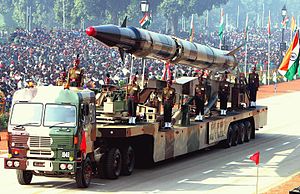Agni-II
| Agni-II | |
|---|---|
 An Agni-II on a road-mobile launcher displayed at the Republic Day Parade 2004. | |
| Type | Medium Range Ballistic Missile |
| Place of origin | India |
| Service history | |
| In service | Active[1] |
| Used by | Strategic Forces Command |
| Production history | |
| Designer | Defence Research and Development Organisation |
| Manufacturer | Bharat Dynamics Limited |
| Unit cost | ₹25 crore (US$3.0 million) to ₹35 crore (US$4.2 million)[2] |
| No. built | 12 (2017 est.)[3] |
| Specifications | |
| Mass | 16,000 kg (35,000 lb) |
| Length | 21 m[4] |
| Diameter | 1.3 m |
| Warhead | Conventional high explosive-unitary, penetration, sub-munitions, incendiary, thermobaric, strategic nuclear weapon |
| Warhead weight | 1,000 kg (2,200 lb)[5] |
| Engine | Multi-stage solid rocket |
| Propellant | Solid fuel |
Operational range | 2,000–3,500 km[6][5] |
| Flight ceiling | 405 km[7] |
| Flight altitude | 230 km[4] |
| Maximum speed | 3.5 km/s (14,040 km/h)[8] |
Guidance system | Mid-course: Ring laser gyro inertial navigation system. Optionally augmented by GPS/NavIC satellite guidance Terminal: Radar scene correlation. Upgraded to active radar homing. |
| Accuracy | 30–40 m CEP[5][9] |
Launch platform | Ashok Leyland/Tata transporter erector launcher |
Agni-II (IAST: Agni, lit. 'Fire'), is the second strategic ballistic missile of the Agni family envisaged to be the mainstay of the Indian missile-based strategic nuclear deterrence. The Agni-II is a medium-range ballistic missile (MRBM) with two solid fuel stages and a Post Boost Vehicle (PBV) integrated into the missile's Re-entry Vehicle (RV). The Agni's manoeuvring RV is made of a carbon-carbon composite material that is light and able to sustain high thermal stresses of re-entry, in a variety of trajectories. The Agni-IIA is a more advanced version of Agni-II, albeit with more sophisticated and lighter materials, yielding a better range and operating regime. Agni-IIA was later renamed as Agni-IV plugging the gap between Agni-II and Agni-III. While the first test of Agni-IV in December 2010 was a failure, the second test flight in November 2011 was a success[10] Agni-II, developed as part of medium- and long-range Agni series of missile systems, has already been inducted into the Armed Forces.[11]

On 17 May 2010, the trial was conducted with a Strategic Forces Command (SFC) of nuclear-capable Agni-II ballistic missile, with a range of 2,000 kilometres from the Wheelers Island off Orissa coast thus making Agni-II missile operational by army.[12] US Air Force National Air and Space Intelligence Center estimating that as of June 2017 less than 10 launchers were operationally deployed,[13] operated by the 335 Missile Group of Regiment of Artillery at Secunderabad using 12 TEL vehicles.[14]
Agni-II can reach all of Pakistan and most parts of south and southeastern China.[15]
See also
[edit]Related development
Related lists
References
[edit]- ^ Press Trust, of India. "India Test Fires Medium Range Nuclear Capable Agni-II Missile". The Times of India. Retrieved 22 September 2019.
- ^ "Technical tune to Agni test before talks". The Telegraph. Calcutta, India. 30 August 2004. Archived from the original on 11 December 2007. Retrieved 13 December 2007.
- ^ The Military Balance 2017. 14 February 2017. ISBN 9781857439007.
- ^ a b Mallikarjun, Y. (18 May 2010). "Agni-II missile test-fired successfully". The Hindu. Chennai, India. Retrieved 20 October 2011.
- ^ a b c "Design Characteristics of India's Ballistic and Cruise Missiles" (PDF). Retrieved 22 September 2019.
- ^ "Missile Detail". Archived from the original on 18 October 2012. Retrieved 24 December 2012.
- ^ "Agni II". Bharat Rakshak – Missiles Section. Bharat Rakshak. Archived from the original on 14 April 2012. Retrieved 20 October 2011.
- ^ Vishwakarma, Arun (1 July 2007). "Indian Long Range Strategic Missiles" (PDF). Lancer Publishers and Distributors. Archived from the original (PDF) on 29 November 2007. Retrieved 13 December 2007.
- ^ "Agni-II | Missile Threat".
- ^ T.S. Subramanian (15 November 2011). "Missile success". The Hindu. Retrieved 20 September 2012.
- ^ Mallikarjun, Y. (17 May 2010). "Agni-II missile test-fired successfully". The Hindu. Chennai, India.
- ^ Super Admin (17 May 2010). "Agni-II test fired successful". News.oneindia.in. Archived from the original on 13 March 2012. Retrieved 20 October 2011.
- ^ Ballistic and Cruise Missile Threats
- ^ "Agni-2". Missilethreat.com. Archived from the original on 18 October 2012. Retrieved 20 September 2012.
- ^ "India | Countries | NTI". Archived from the original on 25 March 2016.
| Aeronautics |
| ||||||||||||||||||||||||
|---|---|---|---|---|---|---|---|---|---|---|---|---|---|---|---|---|---|---|---|---|---|---|---|---|---|
| Armaments |
| ||||||||||||||||||||||||
| Armoured fighting vehicles |
| ||||||||||||||||||||||||
| Electronics, computer science |
| ||||||||||||||||||||||||
| Missile systems |
| ||||||||||||||||||||||||
| Bombs |
| ||||||||||||||||||||||||
| People |
| ||||||||||||||||||||||||
| Engines | |||||||||||||||||||||||||
| Important programmes | |||||||||||||||||||||||||
Text is available under the CC BY-SA 4.0 license; additional terms may apply.
Images, videos and audio are available under their respective licenses.
